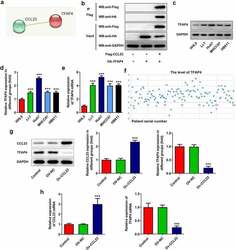Antibody data
- Antibody Data
- Antigen structure
- References [1]
- Comments [0]
- Validations
- Other assay [1]
Submit
Validation data
Reference
Comment
Report error
- Product number
- PA5-100686 - Provider product page

- Provider
- Invitrogen Antibodies
- Product name
- CCL23 Polyclonal Antibody
- Antibody type
- Polyclonal
- Antigen
- Synthetic peptide
- Description
- Antibody detects endogenous levels of total CCL23.
- Reactivity
- Human, Mouse
- Host
- Rabbit
- Isotype
- IgG
- Vial size
- 100 μL
- Concentration
- 1 mg/mL
- Storage
- -20°C
Submitted references Inhibitory effect of CC chemokine ligand 23 (CCL23)/ transcription factor activating enhancer binding protein 4 (TFAP4) on cell proliferation, invasion and angiogenesis in hepatocellular carcinoma.
Wang W, Wu J, Dai X, Cheng K
Bioengineered 2022 Jan;13(1):1626-1636
Bioengineered 2022 Jan;13(1):1626-1636
No comments: Submit comment
Supportive validation
- Submitted by
- Invitrogen Antibodies (provider)
- Main image

- Experimental details
- Figure 2. CCL23 inhibits TFAP4 expression in hepatocellular carcinoma cells. (a) Analysis of the association between CCL23 and TFAP4 according to the STRING database. (b) A Co-IP assay was used to confirm the connection between CCL23 and TFAP4. (c and d) The expression level of TFAP4 in the cell lines was determined using Western blotting and (e) RT-qPCR. (f) The expression level of TFAP4 in HCC tissues was determined using bioinformatics analysis. (g) Detection of CCL23 and TFAP4 protein levels in Huh-7 cells transfected with Ov-NC and OV-CCL23. (h) Detection of CCL23 and TFAP4 mRNA levels in Huh-7 cells transfected with Ov-NC and OV-CCL23. The results are representative of at least three independent experiments. ***P < 0.001 vs. control group.
 Explore
Explore Validate
Validate Learn
Learn Western blot
Western blot Immunohistochemistry
Immunohistochemistry Other assay
Other assay